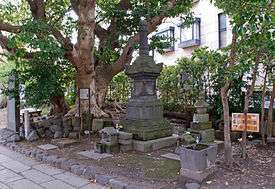Hatakeyama Shigeyasu

Hatakeyama Rokurō Shigeyasu (畠山 六郎 重保) was a Kamakura period warrior who fell victim of political intrigue in 1205. The grave under a tabu no ki tree near the Yuigahama end of Wakamiya Ōji Avenue in Kamakura, Kanagawa Prefecture, Japan and next to Tsurugaoka Hachiman-gū's first torii (Ichi no Torii) is traditionally supposed to be his. The relationship between the grave and Hatakeyama Shigeyasu is, the traditional attribution notwithstanding, unclear.[1] The reasons for the attribution are probably that it lies within the former Hatakeyama estate, and that Shigeyasu is known to have been killed in battle by Hōjō soldiery in Yuigahama.[2]
Next to the hōkyōintō stands a black stele (on the left in the photo) erected in 1920 which explains the circumstances of his death. Its text reads:[3]
Hatakeyama Shigeyasu's residence
Hatakeyama Shigeyasu was Hatakeyama Shigetada's eldest son. He had had a quarrel with Hiraga Tomomasa, who was Hōjō Tokimasa's son-in-law. Tomomasa hadn't forgotten the fact and so spoke to Tokimasa against both the Hatakeyama. Tokimasa himself hadn't forgotten how Shigetada had, following Minamoto no Yoritomo's will, tried to protect the shogun's son and heir Yoriie, and was looking for an excuse to kill them. Having received from shogun Sanetomo the order to arrest the Hatakeyama, he surrounded Shigeyasu's residence with his soldiers. Shigeyasu fought well, but in the end was killed. The day was June 22, 1205,[4] and this is where the residence stood. The day after, Shigetada himself was tricked into going to Musashinokuni's (a region in the north eastern part of Kanagawa) Futamatagawa, where he was killed.
Erected in March 1922 by the Kamakurachō Seinendan
Shigeyasu was one of the samurai who, in December 1204,[5] was chosen to go to Kyoto to pick up shogun Sanetomo's wife, and it was in that occasion that, at a feast, he had a verbal fight with Hiraga Tomomasa, who was responsible for the capital's defenses.[1] It appears that this fact, plus the hostility existing between Shigetada and Tomomasa, who had neighboring fiefs, offered the Hōjō a pretext to get rid of the Hatakeyama clan, that consequently became extinct.[1] It would be revived later by Hōjō Tokimasa.
The legend of the Bofuseki
A legend ties a large rock called Bofuseki (慕夫石 husband-loving rock) on a hill called Ishikiriyama (石切山) behind Jufuku-ji to Hatakeyama Shigeyasu's wife.[6] The legend says that, when Shigeyasu was killed in battle at Yuigahama his wife climbed to the top of the hill to see what was happening and was turned into hard stone by her grief.[6]
See also
Notes
- 1 2 3 Kamiya (2008:223-225)
- ↑ Nihon Rekishi Chimei Taikei
- ↑ Original Japanese text available here
- ↑ Old Japanese lunar calendar date. Gregorian date obtained directly from the original Nengō using Nengocalc: July 10, 1205 (Genkyū 2, 22nd day of the 6th month)
- ↑ Date obtained directly from the original Nengō using Nengocalc
- 1 2 Mutsu (1995:178)
References
- Mutsu, Iso (1995/06). Kamakura. Fact and Legend. Tokyo: Tuttle Publishing. ISBN 0-8048-1968-8. OCLC 33184655. Check date values in:
|date=(help) - "Nihon Rekishi Chimei Taikei (日本歴史地名大係), online version". Hatakeyama Shigeyasu no Haka (in Japanese). Heibonsha. Retrieved 2008-09-18.
- Kamiya, Michinori (2008). Fukaku Aruku - Kamakura Shiseki Sansaku Vol. 1 (in Japanese). Kamakura: Kamakura Shunshūsha. ISBN 4774003409.
- Yuigahama by the Kamakura Citizen's Net, accessed on September 21, 2008